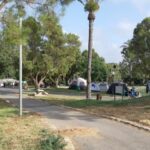Enjoy an unforgettable unique nature reserve on a magnificent shoreline.
Blue bays and rocky crevices, sandstone ridges and rare plants, sea turtle nesting sites, the remains of the biblical town of Akhziv, and the sea-pool bathing beach.
Akhziv National Park covers an area of 450 dunams. The site was declared as a national park in 1968.
Akhziv National Park is on the Mediterranean shore, some 5 km north of Nahariya. Entry is from Road 4, taking the first left turn after Kibutz Gesher Haziv, between the markers for kilometer 245 and kilometer 246.
Settlement began during the Canaanite period (the 18th century BCE), and its great importance was due to the fact that it was a port and waystation along the “sea route” that followed the length of the coast.
In the Bible, Akhziv is a Canaanite town that was not captured by the tribe of Asher, evidence of its strength: “Asher drove not out the inhabitants of Acco, nor the inhabitants of Zidon, nor of Ahlab, nor of Achzib” (Judges 1:31). During the period of the kings of Israel, the area was controlled by the Phoenicians. They developed the port of Akhziv, which was an important base for their maritime commercial voyages. The Phoenicians refined the glass industry and created woven fabrics colored purple with a dye produced from the Mediterranean Sea snail.
Assyrian sources state that Sennacherib conquered the town on his third expedition to Phoenicia and the land of Israel (701 BCE).
During the Crusader period the town was called Casale Umberti, after the knight Hubert of Pacy, who was granted possession by the Crusader king Baldwin I (1104 CE).
The Mameluke sultan Baibars apparently captured Akhziv in 1271, and thereafter there was a small village here called Az-Zib, a name that preserves the name of the ancient settlement. Most of the ruins that are visible today are the remains of the ancient village and the Crusader fortress that were here.
Vegetation on the seashore is affected by the salt spray carried by the wind, and only plants that are resistant to salt spray can survive here.
Living on the Ladder Ridge cliff are groups of rock hyrax (Procavia capensis).
There are also mammals living on the sandy shores, including the red fox (Vulpes vulpes), and rodents such as Tristram’s jird (Meriones tristrami) and the great Egyptian gerbil (Gerbillus pyramidum). Common birds here are seagulls (Larus) and various Charadriiformes, feeding on creatures right on the seashore itself.
For Visiting Hours and prices:










